Scroll from the bottom up to read in chronological order.
8:35pm: Better Late Than Never.
We don’t know who needs to hear this, but it’s not too late to register to vote.
In past years, that kind of procrastination would’ve left you SOL. But you can thank Gov. Gavin Newsom for signing legislation last year to allow same-day voter registration. The law also lets you update political party preference up until the polls close.
The only catch? That you do it at one of the county’s designated voting centers, which shouldn’t be a problem since we have well over 100 to choose from.
One more day! Tomorrow is Election Day, you still have time to register and vote. Vote Centers are open at 7:00am—Skip the lines and vote! #sccvotes pic.twitter.com/LXi3U20Fea
— Registrar of Voters (@sccvote) March 3, 2020
—Jennifer Wadsworth
7:28pm: Money Matters.
The San Jose mayor spent 20 minutes on Facebook Live fielding questions (a few clearly staged) about Measure E ... and wouldn’t ya’ know it? Yes-on-E hype-man Sam Liccardo addressed some of the same concerns the city’s resident anti-taxxer, Pat Waite, expressed to us earlier this evening.
Waite posed his initial query at the 6:18 mark: “How can you claim you prevent future councils from diverting funds to other needs ... like the $3.5 billion unfunded pension liability ... when you can’t?”
The answer? In short, that the council already vowed to allocate the funds for housing and enshrined that pledge in a resolution requiring a supermajority vote to reverse it.
Waite remained skeptical. “Basically you’re asking us to trust you and every future council,” he followed up in a comment at 10 minutes, 26 seconds into the broadcast.
“There is only on way to ensure that there’s trust in government and that is to ensure that there’s transparency in government,” Liccardo replied. “And that’s the way we ensure accountability. So that’s why a citizen’s oversight committee was created in this case—to ensure that there's a clear eye to how these dollars will be used ... so we can know exactly where those dollars are going and exactly how those dollars were spent.”
A former Liccardo spokeswoman echoed his assurance in the comments, telling Waite that “there are such strict guard rails in place it would be nearly impossible to redirect these dollars to anything other than housing/homelessness.”
—Jennifer Wadsworth
5:23pm: Massive A-Tax.
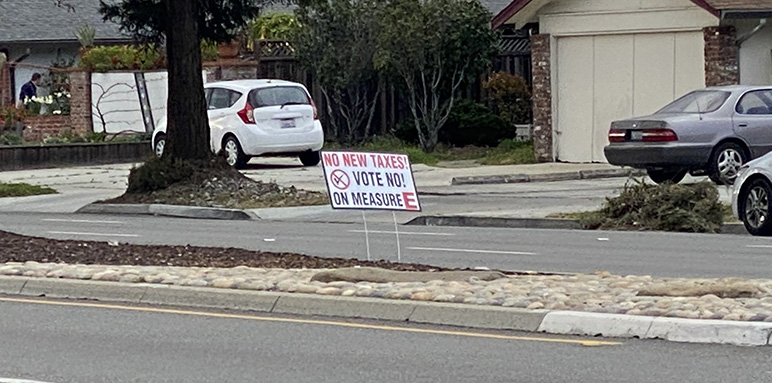
A No-on-E sign spotted in south San Jose. (Photo by Monica Mallon)
To read more about Measure E, scroll to our explainer two posts down. This update is strictly about why some people oppose the property transfer tax.
As much as he hates to say it, Citizens for Fiscal Responsibility frontman Pat Waite has a feeling the measure will pass tomorrow. The tax on home sales over $2 million is being sold to voters as a way to fund affordable housing and services for the homeless. But it’s a general tax, which means whatever revenue it brings into the city coffers goes to the general fund without being earmarked for a specific use.
That’s the problem, according to Waite and his small cohort of fellow fiscal conservatives.
“It’s well intentioned,” he offers before going on to express his concerns about the tax ultimately being used for anything other than housing and homeless services.
Alas, Waite says, the measure’s likely to win anyway.
While the Yes-on-E camp raised $370,000, according to the most recent available campaign filings, Waite says opponents haven’t raised a dime. “The folks who would naturally oppose it don’t want to get on the wrong side of the mayor,” he says.
That said, some signs of undisclosed origin have been spotted around town demanding, in big bold letters, “NO NEW TAXES. VOTE NO! ON MEASURE E [sic]”
The white-and-red placards appear to violate state election laws requiring notice about who funds them. But Waite says he’s unsure who’s responsible for the rogue displays.
—Grace Hase
4:47pm: Weed the People.
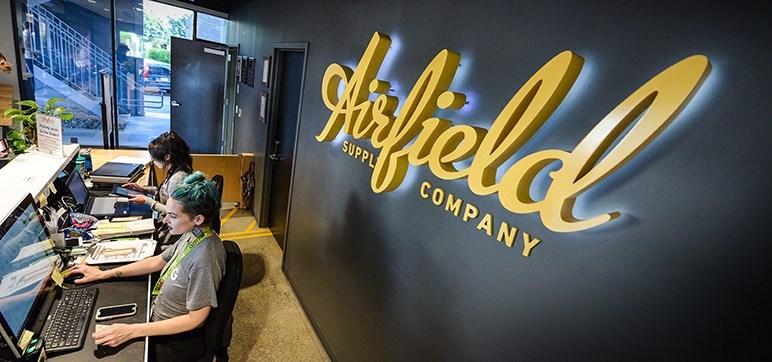
One of San Jose's biggest dispensaries has been urging its customers to vote. (Photo by Greg Ramar)
We’re 27 minutes too late to post this at 4:20. But this is still very much a 420 post.
The 2020 primary is the first time that Sean Kali-rai can recall the local cannabis industry officially organizing people to #GOTV.
The seasoned cannabis consultant and president of the Silicon Valley Cannabis Alliance says weed shops’ civic engagement in San Jose typically deals with strictly cannabis-related initiatives. But this year, Airfield Supply—one of San Jose’s biggest canna-businesses, and one that Kali-rai represents—has been consistently reminding its customers to cast their ballots on March 3.
“I think it’s particularly noteworthy that [with] cannabis [users], your voter tends to be more Democratic, more independent and generally more progressive,” Kali-rai notes.
Airfield Supply launched its get-out-the-vote campaign via email and social media.
“Just being civically engaged matters,” Chris Lane, Airfield’s marketing chief, says. “From our perspective, this is about identifying with your beliefs and taking action for them.”
Wise words. And with just 28 hours and 14 minutes (as of this update) until polls close, you could say it’s high time to heed that advice.
—Grace Hase
3:27pm: Made to Measure.
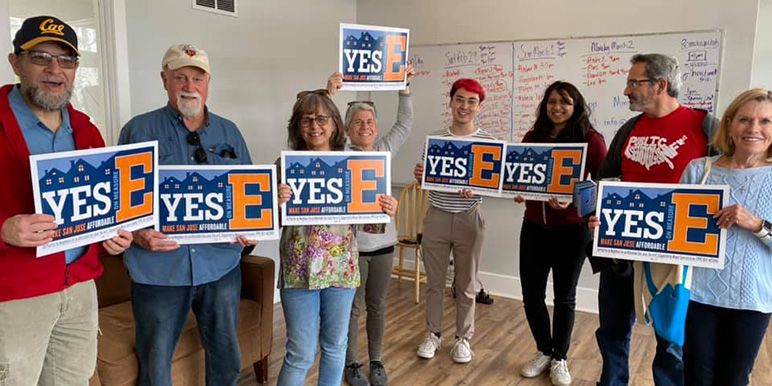
Measure E backers are going door to door to drum up last-minute support. (Photo via SV@Home Action Fund)
San Jose voters have just one city initiative on their ballots this Tuesday: Measure E.
City officials proposed the policy last year as a means to generate more revenue for affordable housing and homeless services. A previous measure that was supposed to address some of these concerns with $450 million in general obligation bonds failed at the hands of voters in November 2018.
Measure E proposes a real property transfer tax on homes priced above $2 million. It’s expected to rake in $70 million annually, according to city officials, and needs a simple majority to pass. While money from the tax will go into the city’s general fund, the council in December passed a spending plan to ensure the tax dollars are used wisely.
The spending plan is as follows:
- 10 percent for homeless prevention and rental assistance
- 45 percent for permanent supportive housing and affordable rental housing for extremely low-income households
- 35 percent for rent subsidies to households making 30 to 80 percent of the area median income
- 10 percent for below-market-rate for-sale housing and to assist moderate-income earners with down payments to buy their first home
With less than 24 hours until the polls close, San Jose Inside caught up with some of the proponents of Measure E to see how they’re feeling going into Election Day.
Michael Lane, the deputy director of Silicon Valley@Home, says the response he’s seen from voters while out on the campaign trail has been largely positive. The SV@Home Action Fund has helped lead the efforts in support of Measure E.
“Affordable housing and homelessness is really at the top of voters minds,” Lane tells us.
When we caught up with Lane, he was running a traditional Get Out The Vote drive, trying to reach out to last-minute voters who have yet to cast their ballots.
Kevin Zwick, the CEO of Housing Trust Silicon Valley, says he was out on the campaign trail this past weekend to knock on doors in San Jose’s Berryessa neighborhood. “I’m feeling good,” he says in a phone call. “San Jose voters all agree we have a housing crisis and they also know there’s not enough funding to address it. … Measure E gets the city new resources to help address the affordable housing and homelessness crisis.”
??????????????????????????????????? https://t.co/pTFZHsg2j3
— Housing Trust SV (@HousingTrustSV) February 29, 2020
Opponents of Measure E couldn’t immediately be reached for comment Monday. However, on the city’s website, Silicon Valley Taxpayers Association President Mark Hinkle, Citizens for Fiscal Responsibility Pat Waite and San Jose Councilman Johnny Khamis are listed as authors of the rebuttal against the measure.
The trio say they oppose the initiative because they don’t want residents to be overtaxed and don’t want to up the cost of buying a home.
“Measure E is a GENERAL TAX (sic),” Hinkle, Waite and Khamis wrote. “Despite the nice wording about affordable housing and helping the unhoused, future City Councils can spend this money on anything they choose. If they spend just $1 on housing, they can say they have kept their commitment.”
—Grace Hase
3:10pm: Voto Latino.
As the fastest growing part of the American electorate, Latinos have become a powerful political force. Especially in California, where they make up a third of registered voters, and in Santa Clara County, where they make up a quarter of the population. Meanwhile, half of San Jose’s East Side is Latino and 38 percent of them are registered to vote.
This year brings a historic milestone in Latino representation. For the first time ever, Latinos comprise the largest minority ethnic group able to vote in a presidential election.
With 32 million Latinos eligible to exercise their right to participate in the democratic process, they’re expected to account for 13 percent of the national turnout this week.
In an effort to garner the kind of Latino turnout experts predict, Santa Clara County Supervisor Cindy Chavez recently made an appearance at ESSJ’s Tully Library Voting Center to urge local youth to come out in full force for Super Tuesday. She was joined by Camille Llanes-Fontanilla, who’s in charge of SOMOS Mayfair, a nonprofit that serves the same neighborhood where the late civil rights activist Cesar Chavez first mobilized Latino voters amid the farmworker strikes in the 1960s.
After reading ample analysis on how the Latino surge stands to impact the presidential race, we reached out to San Jose State political science professor Garrick Percival to find out how he thinks it might sway some of our local contests.
“That’s a good question,” he replies when we ask him about it.
“One of the things to think about with Latino turnout is that as the percentage of the Latino vote grows, the election starts to look a lot like a presidential general election instead of a normal primary,” he says. “That means, you know, a higher turnout, more of a youth vote and one that’s more Democratic leaning.”
With that in mind, Percival says he can see that trend shaping the outcome of a couple South Bay races, including the one for State Senate District 15.
“I think a bigger Latino turnout would help Nora Campos,” he says of the former assemblywoman and San Jose councilor. “Nora represented large swaths of East Side San Jose for a number of years, of course, so I can see that working in her favor.”
But it’ll be interesting to see how the Latino vote breaks down between Campos and Dave Cortese, he adds. Cortese garnered strong Latino support from San Jose’s East Side when he ran against Sam Liccardo for mayor in 2014. And as a county supe over the past dozen years, he maintained a public profile in some of the same largely Latino communities.
However, Percival adds, it’ll be tough for both Campos and Cortese to make the top two and, thus, into the fall runoff.
Another race that Latinos may decide is the one for the seat that Cortese’s leaves open when he terms out at the year’s end. Of the four folks trying to become the county’s next D3 supervisor, one—Magdalena Carrasco—is Latino.
As San Jose’s District 5 councilwoman, Carrasco serves some parts of the supervisorial district she’s running for, which may give her an edge. “But yeah,” Percival says, “that’s another one where you could see the Latino vote having a big effect on what I think will be a pretty tight race.”
Even so, the SJSU poli-sci prognosticator says he thinks the county race is more likely to result in a runoff between former Sunnyvale Mayor Otto Lee and Assemblyman Kansen Chu. “That’s been my thinking going into this,” Percival says. “But it’s hard to say.”
—Jennifer Wadsworth
11:15am: Ready, Set, Vote.
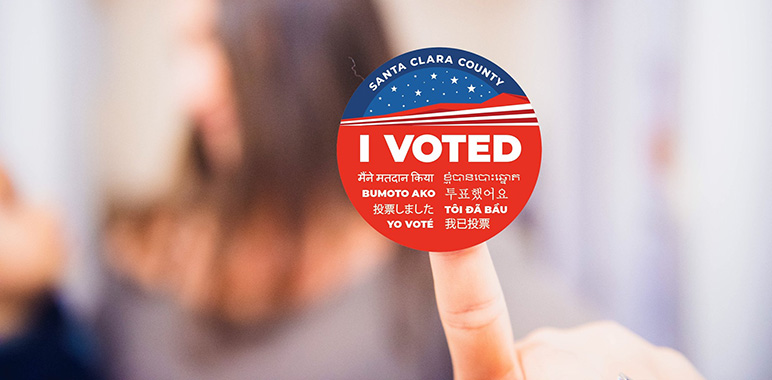
Have you voted yet? (Photo via Santa Clara County ROV)
Here we are. Just a day away ’til Super Tuesday.
Candidates are knocking on doors. Their sign-carrying minions are working the phone banks. An army of volunteers will hustle until polls close to #GetOutTheVote.
Of course, with Santa Clara County sending a mail-in ballot to every registered voter and opening a gajillion drop-off locations, much of the vote’s already gone out.
“Yup, it’s jumpin,’” Eric Kurhi, a spokesman for the Santa Clara County Registrar of Voters (ROV), wrote in an email late Monday morning.
By the latest count, he said, 183,553 ballots have already found their way to the ROV while another 4,872 have been dropped off at one of the county’s 110 Vote Centers. All told, that’s 188,425 ballots out of 955,328 sent to registered voters—a 20 percent turnout.
San Jose Mayor Sam Liccardo’s spokesfolks sent out a press release about his plans to take advantage of early voting by dropping off his ballot at the Tully Branch Library.
For anyone else who wants to follow his lead by voting early, there are several options.
You can vote by mail—no postage required—as long as you use the designated return envelope and stick it in the mailbox on or before Election Day. A word of caution, though: the U.S. Postal Service has been grappling with staffing shortages and delivery delays, so there’s a chance that your ballot might miss the Friday deadline to arrive at the ROV.
It’s probably better to just drop it off in person, which you can do at any Vote Center in the county (to find the nearest one, click here). Or, you can bring it straight to the ROV’s main hub at 1555 Berger Drive in San Jose.
The wider range of ballot-casting options is part of a new-ish law called the Voter’s Choice Act, which rolled out in San Mateo, Sacramento, Napa, Nevada and Madera counties in 2018 and Santa Clara County just this year. The local ROV created a landing page explaining the initiative right here. Basically, it does away with traditional polling places and allows people to cast their ballot at any of one of 100-plus voting centers throughout the county.
That added convenience coupled with excitement over the Democratic presidential nomination have set expectations for a pretty high turnout. The South Bay alone has enough competitive races to inspire a greater-than-usual number of voters.
County Supervisor Dave Cortese’s impending departure has drawn a field of four contenders vying to replace him on the five-member Board of Supervisors.
In San Jose, five City Council seats are up for grabs in District 2, District 4, District 6, District 8 and District 10—the latter an open seat.
Countywide, there are more than 20 local measures, most of them school bonds.
In Milpitas, voters will weigh in on a three-way race for the local school board. Registered Democrats have 10 delegate positions to vote for. Santa Clara will elect a new police chief.
Among state and federal races, the contest for the 15th State Senate District has drawn widespread attention. Jockeying to replace state Sen. Jim Beall when he terms out are county Supervisor Dave Cortese, former FEC chair Ann Ravel, ex-Assemblywoman Nora Campos, San Jose Councilman Johnny Khamis, paratransit driver Tim Gildersleeve, retired Army Staff Sgt. Ken Del Valle and mechanical engineer Robert Howell.
Silicon Valley’s Congressional incumbents Ro Khanna, Anna Eshoo, Jimmy Panetta and Zoe Lofgren face only token opposition. As do Assembly members Ash Kalra, Robert Rivas, Mark Stone and Evan Low.
The open 13th State Senate seat, however, garnered seven candidates. Another highly competitive race is the one for the 25th Assembly District, where nine people are running for the seat that opened up when the incumbent, Kansen Chu, surprised everyone by announcing his bid for Cortese’s county supe seat instead.
There are plenty of races to watch, so grab your popcorn, check this space for updates and submit election-related tips to yours truly at [email protected] or to my colleague Grace Hase at [email protected].
—Jennifer Wadsworth

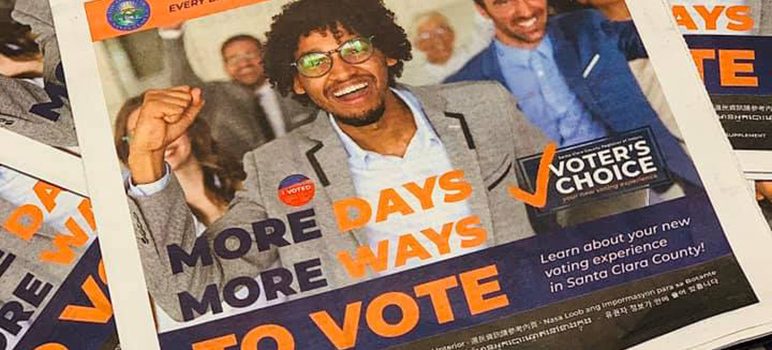



I voted for Biden already. I like Amy best but new she would drop out eventually. It is time to take COMMUNIST Bernie Sanders out! The Bernie people are not Democrats. They are communists disguised as Democrats. The Florida Latino Democrats are having the first ever anti communist concert in April to clap back at Bernie’s communist comments related to a Fidel Castro’ “Educational” [indoctrination] system.
> It is time to take COMMUNIST Bernie Sanders out! The Bernie people are not Democrats. They are communists disguised as Democrats.
Reports in the NYT and other places suggest that this is exactly what the Democrat Party elders are thinking.
After the Democratic convention in July, the Democrat Party will effectively split. I’m betting on a Marxist party and a social welfare party.
It will be fascinating to how Hillary Clinton makes here grand entrance to accept the nomination as the “unity candidate” for the party.
I expect the Bernie Bro’s and AntiFa will have long faces, melancholy, and experience a certain measure emotional distress.
The Unity Candidate:
Tanned, rested, and ready.
https://sjoutsidethebubble.files.wordpress.com/2020/03/hillary_smile.jpg
Poor Bernie,
The Deep State Players all set to torpedo the little old white guy, play the same game on Bernie as they did on Trump. He’s a Putin plant, honeymooned in the USSR loves Fidel. Thinks bread lines are a good thing. Bring on the Russia Collusion hysteria, have Hillary give the phone number of Fusion GPS to Mike Bloomwormer to write up a new Steel dossier on the little tramp and watch ANTIFA burn down Milwaukee, and then New York. Adam Schitt can start adding up charges of impeachment if Burnie doesn’t have a heart attack and drop out before the convulsion.
Then you realize your only hope for a win is Plugs Biden suffering from mid stage dementia and may have to be replaced
before he is inaugurated by Beto O’Rourke the fake Mexican or Pocahontas the fake Indian.
Suddenly you realize Trump is filling your 401 with cash and you will be able to retire at 65, if he wins!
I resent being tagged as an “anti-taxer.” I have supported tax increases that I felt were justified and would best serve the residents of San Jose and other jurisdictions. I have supported all recent tax increases proposed by the Evergreen School District, which is generally well run with respect to managing overhead dollars. I supported Measure T in 2018 because the funds were dedicated to desperately needed infrastructure projects.
I oppose Measure E because the Measure itself is a general fund tax that cannot have its use permanently restricted by any Council. It is well-intentioned, and this Council has chosen to enact “guard rails” to devote the funds to our housing and homelessness issues. Future Councils can just as easily remove the restrictions to use the funds to avoid laying of public safety employees, for instance. The move will be sold as temporary, but once removed, there is close to zero chance that they will ever be put back in place.
When the next recession hits, which may be sooner due to the havoc caused by the Coronavirus, how long before a Council chooses to do just that?
Seems to me Measure E ought to be rejected solely on the basis that it’s sponsors have zero respect for the law and by definition zero respect for their constituents. A tax that funds a specific purpose requires a 2/3 majority. These cheaters in City hall have figured out a way to cheat the system.
Congratulations cheaters. Ya got us.
> These cheaters in City hall have figured out a way to cheat the system.
Well, I feel like I’ve been cheated. And, just so I learn the appropriate lesson, I would like to know HOW I’ve been cheated.
Is there someone among the thousands of bureaucrats and watchdogs we pay for whose job is to check and verify that every provision of California law was complied with and that all “i’s” were dotted and all “t’s” were crossed?
If this was all legal and above board, we need more laws, because it SHOULDN”T be legal and above board.
One thing about this tax that seems especially unfair and obnoxious is that it is only paid by a tiny sliver of the population: people who sell houses worth two million or more. Probably only a few thousand such people in a year. Out of a population of millions, that is REALLY targeting the “one percent”. Actually, much less than one percent.
The whole point of Constitutional government is to protect tiny minorities from the predation of the mobs.
Constitution! DO YOUR DUTY!
> It is well-intentioned, and this Council has chosen to enact “guard rails” to devote the funds to our housing and homelessness issues.
So, if the “housing and homelessness issues” are finally solved, does the tax go away?
OF COURSE IT DOESN’T.
This tax is NOT “well-intentioned”.
It is no more well-intentioned than a mini-market stick-up,
“Gimme da money.”